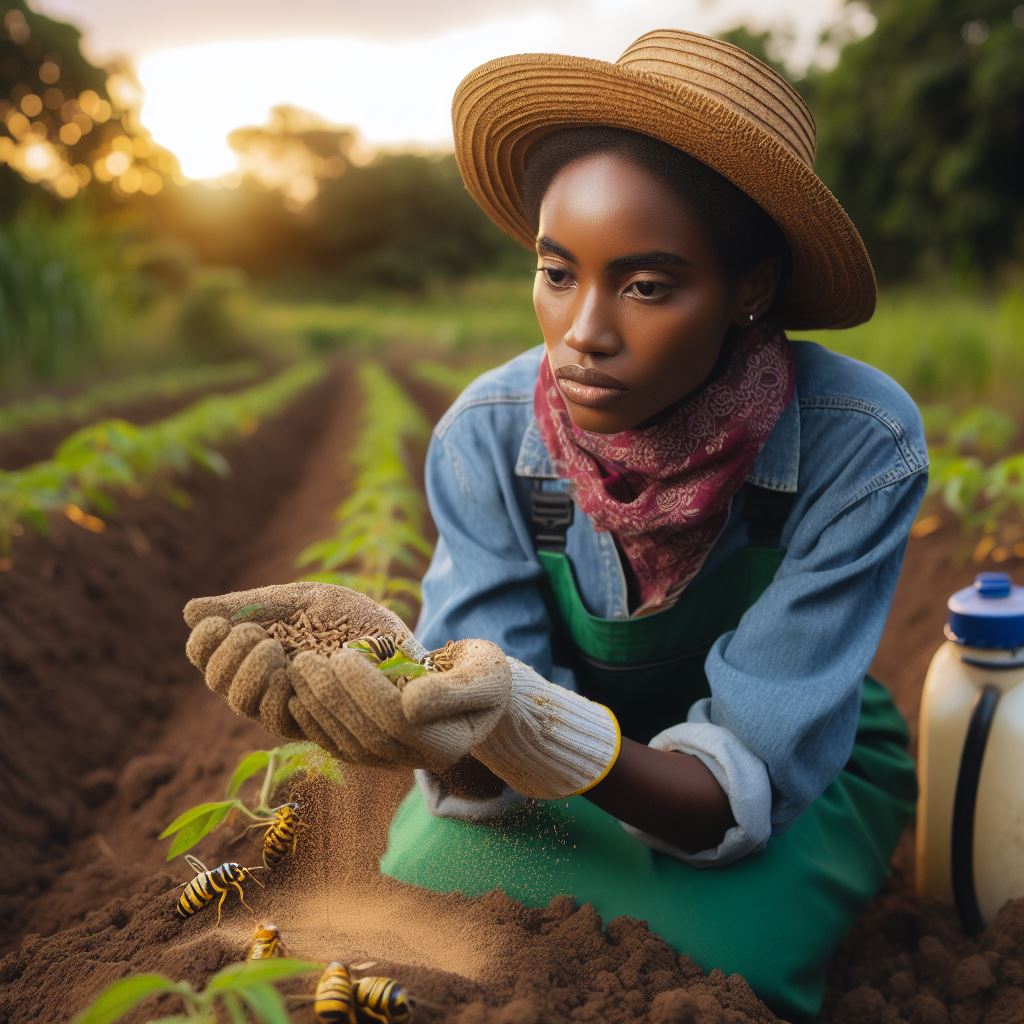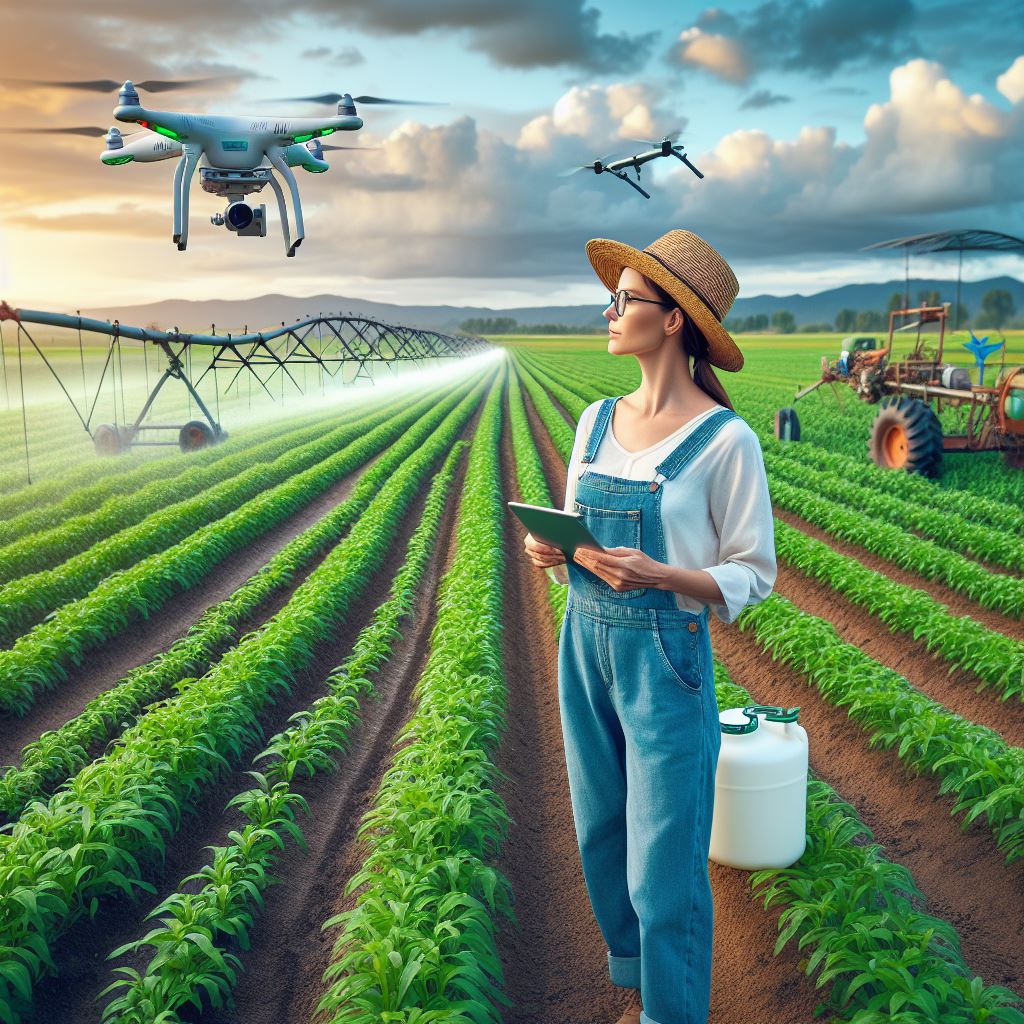Introduction
Crop pest infestations pose significant threats to agricultural productivity and farmer’s income.
Implementing effective Integrated Pest Management (IPM) strategies is crucial to minimize losses while reducing reliance on chemical controls.
Importance of integrated pest management (IPM) and Purpose of the blog post
Integrated pest management (IPM) is crucial in effectively managing common crop pests.It is crucial for sustainable agriculture and environmental preservation.
By incorporating various strategies like biological controls, cultural practices, and judicious use of pesticides, IPM minimizes pest damage while reducing reliance on harmful chemicals.
This approach promotes long-term pest control solutions, preserving biodiversity and ecosystem health. It enhances crop resilience to pests and reduces pesticide residues in food, safeguarding human health.
Economically, IPM can lower production costs and mitigate risks associated with pesticide resistance.
Ultimately, IPM fosters a balanced ecosystem, ensuring agricultural productivity while minimizing environmental impact, making it vital for sustainable food production globally.
The purpose of this blog post is to provide insights and strategies for implementing IPM.
Understanding Common Crop Pests
Definition of crop pests
Crop pests are organisms that damage crops, decreasing their yield and overall quality.
Types of common crop pests
- Insects: These include aphids, beetles, caterpillars, and weevils that feed on crops.
- Diseases: Fungal, bacterial, and viral infections that impact crop health and productivity.
- Weeds: Unwanted plants that compete with crops for resources like water and nutrients.
- Nematodes: Microscopic worms that attack plant roots, causing stunted growth and yield loss.
Causes and impacts of crop pest infestations
- Favorable environments: Lack of crop rotation, inadequate sanitation, and high humidity attract pests.
- Reduced yield: Pests feed on plants, impairing their growth, photosynthesis, and ultimately reducing yield.
- Quality deterioration: Pest damage can lead to physical abnormalities, discoloration, and taste changes.
- Economic losses: Crop pest infestations result in financial losses due to reduced yield and market value.
- Increased pesticide use: Farmers resort to chemical control measures, often resulting in environmental pollution.
- Resistance development: Continuous pesticide use can lead to pests evolving resistance, posing greater challenges in control.
Implementing Effective IPM Strategies
Effective Integrated Pest Management (IPM) emphasizes sustainable and holistic pest control approaches.
Monitoring and identification
- Regular monitoring of crops tracks pest populations, enabling early intervention.
- Accurate pest identification ensures appropriate control measures are employed.
Cultural practices and preventive measures
- Crop rotation disrupts pest lifecycles, reducing pest populations and promoting soil health.
- Sanitation practices, such as removing plant debris, discourage pest infestations.
- Implementing adequate drainage systems minimizes excessive moisture, reducing pest habitats.
- Introducing beneficial insects and plants that repel pests can help maintain a healthy ecological balance.
Biological controls
- Using natural enemies of pests, like parasites, predators, and pathogens, reduces pest populations.
- Biological controls are environmentally friendly and sustainable, contributing to long term pest management.
Mechanical controls
- Physical barriers like nets, fences, and traps limit pest access to crops.
- Handpicking pests or removing infested plant parts manually can effectively control small-scale infestations.
Chemical controls (as a last resort)
- Judicious use of pesticides targeted at specific pests minimizes environmental impact.
- Employing biopesticides and pheromone-based traps reduces chemical reliance and harm to non-target organisms.
Implementing effective IPM strategies is crucial for managing common crop pests sustainably. By combining various preventive and control measures, farmers can minimize crop losses, preserve ecosystem health, and ensure food security for generations to come.
Key Principles of IPM
Definition of IPM
- Integrated Pest Management (IPM) is a sustainable approach to managing pests using multiple strategies.
- It involves carefully monitoring and understanding the pests while minimizing risks to human health and the environment.
- IPM requires proper identification, prevention, and control of pests to maintain healthy crop populations.
- It emphasizes the use of biological, cultural, physical, and chemical control methods.
- IPM encourages the integration of various pest control techniques for effective long-term management.
Importance of Utilizing IPM in Pest Management
- IPM plays a crucial role in reducing the reliance on pesticides, thus minimizing their potential negative impacts.
- By adopting IPM practices, farmers can maintain crop quality and yield while minimizing economic losses.
- It helps to prevent the development of pesticide resistance in pest populations, prolonging the effectiveness of chemical control.
- IPM promotes sustainable agriculture by promoting biodiversity and protecting beneficial organisms.
- It provides a holistic approach that considers the entire ecosystem, leading to healthier and more resilient agricultural systems.
Benefits of IPM over Conventional Pest Control Methods
- IPM is a proactive approach that focuses on preventing pest problems rather than solely relying on reactive treatments.
- Unlike conventional pest control methods, IPM emphasizes the use of least toxic or non-toxic control options.
- By relying on multiple control strategies, IPM reduces the risk of pests developing resistance to specific control measures.
- IPM can significantly reduce the use of chemical pesticides, minimizing environmental pollution and human health risks.
- IPM saves farmers money by reducing the need for continuous pesticide applications and associated costs.
- It promotes the long-term sustainability of agriculture by maintaining ecological balance and reducing negative impacts on non-target organisms.
- IPM ensures that crop pest management aligns with modern consumer preferences and demands for environmentally friendly practices.
- Through IPM, farmers can improve the overall quality of their crops, meeting market standards and consumer expectations.
- Integrated Pest Management fosters a more harmonious relationship with nature, minimizing the disruption of natural ecosystems.
- By implementing IPM, farmers and agricultural workers can minimize their exposure to potentially hazardous pesticides.
Identifying Crop Pest Problems
Techniques for crop pest monitoring and scouting
- Regularly inspect crops for signs of pest activity.
- Employ trapping methods to monitor pest populations.
- Use pheromone traps to attract and capture specific pests.
- Implement visual scouting by walking through fields and visually inspecting plants.
- Set up sticky traps to catch flying pests and monitor their presence.
Key observations for identifying common crop pests
- Look for chewed, skeletonized, or distorted leaves, indicating the presence of chewing pests.
- Inspect plants for small holes, indicating the presence of boring pests.
- Observe sticky residue or shiny trails, indicating the presence of sap-feeding pests.
- Check for wilting or yellowing plants, indicating the presence of root-feeding pests or diseases.
- Notice stunted growth, discoloration, or deformities, indicating the presence of viral or fungal pests.
Documenting and recording pest populations
- Keep a record of pest species, location, and severity.
- Note the stage of pest development (egg, larvae, adult) to determine control options.
- Take photographs when possible, to aid in identification and comparison.
- Monitor changes in pest populations over time for effective pest management decisions.
- Record weather conditions during pest sightings to identify patterns or environmental triggers.
Monitoring and identifying common crop pests are crucial steps in implementing an effective Integrated Pest Management (IPM) program.
By using various techniques for scouting and monitoring, farmers can accurately identify pest problems in their crops.
These methods include regular visual inspections, employing trapping methods, and using pheromone traps to capture specific pests.
Key observations include inspecting leaves, plants, and other signs to identify the presence of chewing, boring, sap-feeding, root-feeding, viral, or fungal pests.
Transform Your Agribusiness
Unlock your farm's potential with expert advice tailored to your needs. Get actionable steps that drive real results.
Get StartedDocumenting and recording pest populations can help in making informed pest management decisions.
Prevention Strategies
Cultural practices to prevent pest problems
- Implementing proper crop spacing and planting density can discourage pests and enhance air circulation.
- Selecting pest-resistant crop varieties can reduce the vulnerability of crops to common pests.
- Regularly monitoring and scouting for pests can help identify potential problems before they become severe.
- Using trap crops, which attract pests away from main crops, can divert the attention of pests.
- Employing physical barriers, such as nets and fences, can prevent pests from accessing crops and causing damage.
Sanitation and hygiene measures to reduce pest populations
- Removing crop residues and weed hosts can eliminate potential breeding grounds for pests.
- Properly disposing of infested plant materials can prevent the spread of pests.
- Regularly cleaning equipment and tools can minimize the risk of pest transfer between plants.
- Practicing proper waste management can discourage pests by removing potential food sources.
- Maintaining clean and weed-free fields can create an unfavorable environment for pests.
Crop rotation and diversification for pest management
- Rotating crops reduces the buildup of pests, as different crops host different pests.
- Incorporating cover crops can provide habitat for beneficial insects that prey on common crop pests.
- Planting a variety of crops helps disrupt pest life cycles, reducing the overall pest population.
- Intercropping, growing two or more crops together, can confuse pests and limit their ability to find host plants.
- Using companion planting, where compatible crops are planted together, can repel pests or attract beneficial insects.
Prevention strategies are essential for effective IPM. Cultural practices, sanitation and hygiene measures, and crop rotation and diversification all contribute to reducing pest problems.
By implementing these strategies, farmers can minimize the use of chemical pesticides while maintaining healthy and productive crops.
Integrated pest management, with a focus on prevention, is a sustainable approach to managing common crop pests.
Read: Eco-Farming: Sustainable Practices Overview

Intervention Techniques
A successful Integrated Pest Management (IPM) strategy involves the use of various intervention techniques to control common crop pests.
These techniques include:
Biological control methods for common crop pests
- Introduction of natural enemies: Beneficial insects, such as ladybugs and parasitic wasps, can be released to prey on pest populations.
- Use of microbial agents: Microorganisms like Bacillus thuringiensis (Bt) can be applied to target specific pests.
- Crop rotation: Planting different crops in sequential seasons disrupts pest life cycles and reduces their population.
Mechanical and physical control tactics
- Mechanical barriers: Physical barriers like nets, screens, and fences can prevent pest access to crops.
- Handpicking: Manual removal of pests helps to reduce their numbers, especially for larger insects like caterpillars.
- Traps: Sticky traps, pheromone traps, or light traps are effective in capturing and monitoring pest populations.
Chemical control options and considerations
- Use of pesticides: Carefully chosen insecticides, herbicides, or fungicides can be used to control specific pests.
- Selective pesticides: Targeted pesticides that have minimal impact on non-target organisms can be employed.
- Application timing: Timing pesticide applications during the vulnerable stages of pest development enhances effectiveness.
- Adherence to safety measures: Proper handling, storage, and disposal of pesticides are imperative for human and environmental safety.
- Resistance management: Rotating and combining different types of pesticides helps prevent pest resistance.
When implementing intervention techniques, it is crucial to consider key factors:
- Pest identification: Accurate identification of the pest species helps determine the most appropriate control method.
- Economic thresholds: Deciding the point at which economic damage justifies intervention prevents unnecessary pesticide use.
- Monitoring: Regular monitoring of pest populations assists in evaluating control efficacy and adapting strategies accordingly.
- Environmental impact: Minimizing the environmental impact of control measures by prioritizing non-chemical options is important.
- Regulatory compliance: Adhering to local regulations and following label instructions helps ensure responsible pesticide use.
- Record keeping: Maintaining detailed records helps track pest management practices and facilitates future decision-making.
By integrating these intervention techniques and considering important factors, growers can effectively manage common crop pests while minimizing the reliance on chemical controls.
Implementing a comprehensive IPM approach not only safeguards crops but also promotes ecological balance and sustainability in agricultural systems.
Read: Boosting Soil Health with Organic Nutrients
Developing Pest Management Plans
Importance of site-specific pest management plans
- Site-specific pest management plans are crucial in effectively controlling crop pests.
- They take into account the unique characteristics and needs of each specific location.
- By tailoring strategies to the site, farmers can achieve more targeted and efficient pest control.
- Site-specific plans prevent unnecessary use of pesticides and reduce environmental impacts.
- They promote sustainable agriculture practices by minimizing chemical inputs.
Considerations for selecting the most effective control methods
- When choosing control methods, farmers should prioritize environmentally friendly options.
- Integrated Pest Management (IPM) techniques should be preferred over chemical treatments.
- Biological control methods, such as the use of natural enemies, can be highly effective.
- Crop rotation and diversification strategies can disrupt pest life cycles and reduce infestations.
- Physical barriers and traps can also provide effective pest control.
The role of technology in enhancing IPM strategies
- Technological advancements have significantly improved IPM strategies
- Precision agriculture tools allow farmers to monitor pest populations more accurately.
- Remote sensing and drones can provide real-time data on pest distribution and damage.
- Data analytics and predictive models help in making informed pest management decisions.
- Automated systems enable targeted application of pesticides, minimizing their overall use.
Developing site-specific pest management plans is crucial for effective IPM in crop production.
By tailoring strategies to individual locations, farmers can achieve targeted and efficient pest control while minimizing the use of chemicals and environmental impacts.
Choosing environmentally friendly control methods, such as biological control and physical barriers, should be prioritized.
Technology plays a key role in enhancing IPM strategies by providing accurate pest monitoring, real-time data, and automated systems.
By integrating these approaches, farmers can effectively manage common crop pests while promoting sustainability in agriculture.
Read: Sustainable Crop Rotation in a New Era
Evaluating IPM Success
A successful Integrated Pest Management (IPM) program relies on effective monitoring and evaluation techniques to ensure its continued success.
By regularly assessing the effectiveness of IPM strategies, farmers and crop managers can identify any issues and make necessary adjustments for better pest management outcomes.
Techniques for monitoring the effectiveness of IPM
To evaluate the success of IPM, several techniques can be employed:
- Pest population monitoring: Regularly monitoring pest populations helps determine if the IPM measures are reducing their numbers.
- Trap monitoring: The use of traps aids in assessing pest activity and provides valuable data for decision-making.
- Disease monitoring: Monitoring disease incidence and severity helps gauge the efficacy of IPM strategies targeting plant diseases.
- Sampling and scouting: Sampling different areas of the crop field and scouting for signs of pests or damage provide essential data for evaluation.
Documenting and analyzing data for evaluating pest management outcomes
Collecting and documenting data on pest management outcomes is crucial for evaluating the effectiveness of IPM. The following steps can help in this process:
- Record keeping: Maintaining detailed records of pest management activities, including the use of pesticides and other IPM methods.
- Data analysis: Analyzing the collected data to identify trends and patterns in pest populations, crop damage, and the efficacy of IPM measures.
- Comparative analysis: Comparing the data from different seasons or fields helps assess the long-term effectiveness of IPM strategies.
- Identifying correlations: Identifying correlations between specific IPM practices and pest population trends helps refine the pest management approach.
Continuous improvement and adapting IPM strategies
Evaluating IPM success also involves continuous improvement and adapting strategies based on the gathered data.
The following approaches can enhance overall IPM effectiveness:
- Regular reviews: Conducting periodic reviews of the IPM program to identify weaknesses and areas for improvement.
. - Learning from experience: Using past experiences and gathered data to fine-tune IPM strategies for better pest management outcomes.
- Farmer and expert collaboration: Engaging farmers, pest control experts, and researchers in evaluating and refining IPM strategies for specific crops.
- Adapting to changing pest dynamics: Being flexible and adaptive to changing pest species, populations, and environmental factors.
By continuously evaluating and adapting IPM strategies, crop managers can optimize pest management outcomes, minimize pesticide use, and reduce environmental impacts.
Showcase Your Farming Business
Publish your professional farming services profile on our blog for a one-time fee of $200 and reach a dedicated audience of farmers and agribusiness owners.
Publish Your ProfileSuccessful IPM depends on active monitoring, data analysis, and a commitment to ongoing improvement.
Read: Drought-Resistant Farming: Tips & Tricks
Explore Further: Secrets to Perfect Crop Cultivation for High Yields
Conclusion
Effective Integrated Pest Management (IPM) is crucial for dealing with common crop pests.
By implementing IPM strategies, farmers can minimize the use of harmful chemicals and promote sustainable agriculture.
It is essential to prioritize IPM practices, such as monitoring pest populations, using biological control methods, and employing cultural and mechanical control techniques.
This holistic approach not only protects crops but also reduces the impact on the environment and human health.
We encourage farmers and experts to share their experiences and tips for implementing IPM.
Together, we can learn from each other’s successes and challenges, leading to continuous improvement in IPM strategies.
By adopting effective IPM practices, we can safeguard our crops, increase productivity, and contribute to a more sustainable and resilient agricultural system.
Let’s work together to create healthier and more environmentally friendly farming practices.




